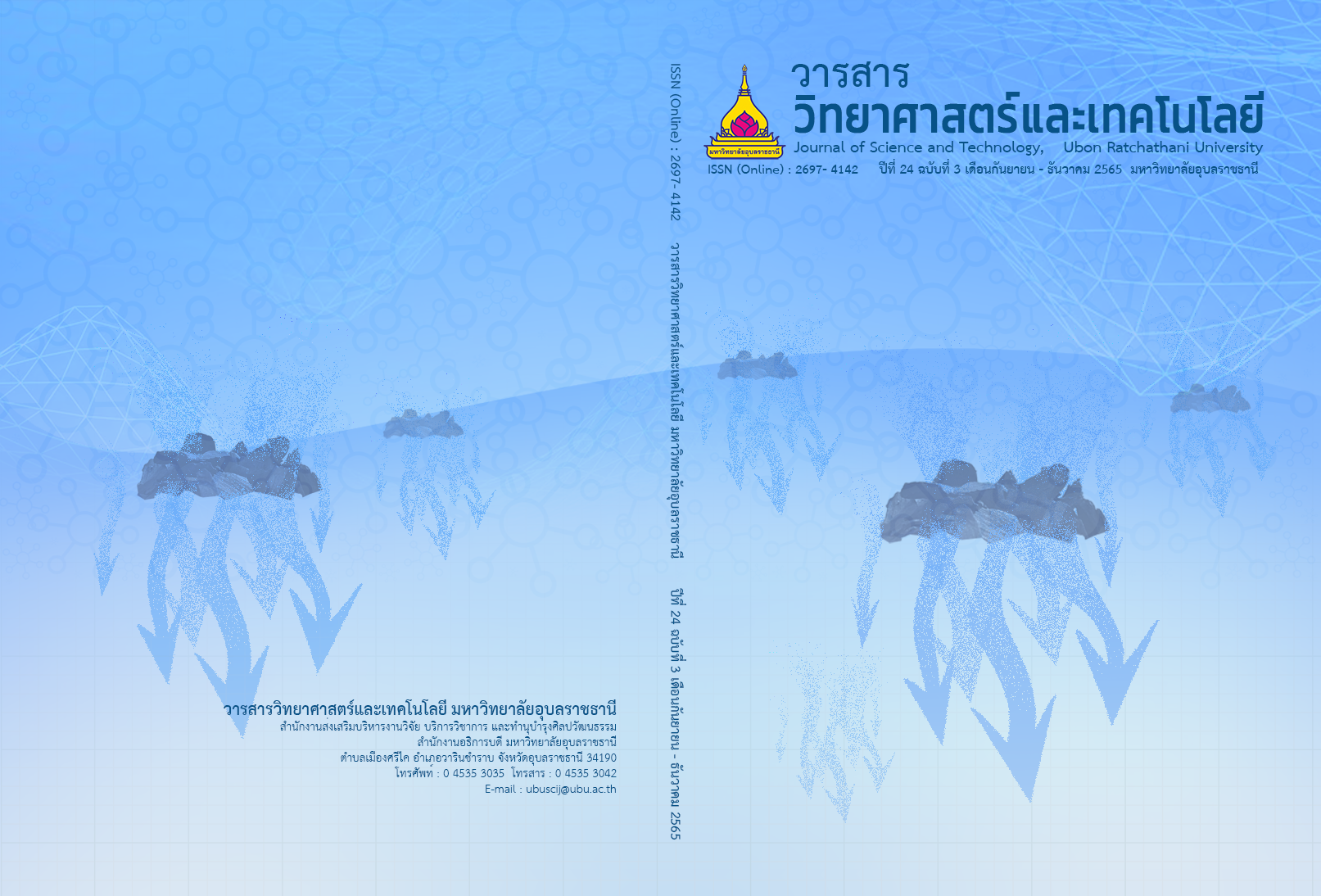ผลของวิธีการสกัดต่อปริมาณสารประกอบฟีนอลิกรวมและฤทธิ์ต้านอนุมูลอิสระ ของตำรับจันทน์ทั้งห้า
Main Article Content
บทคัดย่อ
ตำรับจันทน์ทั้งห้าประกอบด้วยแก่นไม้สมุนไพร 5 ชนิด ได้แก่ จันทน์แดง จันทน์ขาว จันทน์เทศ จันทน์ชะมด และจันทนา
ทางการแพทย์แผนไทยถูกใช้เป็นยาแก้ไข้ แก้ร้อนใน และบำรุงตับปอดหัวใจ อย่างไรก็ตามการศึกษาฤทธิ์ต้านอนุมูลอิสระของตำรับจันทน์ทั้งห้ายังมีไม่มาก การศึกษานี้จึงมีวัตถุประสงค์เพื่อศึกษาผลของวิธีการสกัดต่อปริมาณสารประกอบฟีนอลิกรวม และฤทธิ์ต้านอนุมูลอิสระของตำรับจันทน์ทั้งห้า ในการศึกษานี้ใช้วิธีการสกัด 3 วิธี คือ การแช่ในตัวทำละลาย การชง และการต้มเดือด โดยทั้ง 3 วิธี ใช้น้ำเป็นตัวทำละลาย การวิเคราะห์ปริมาณสารประกอบฟีนอลิกรวมใช้วิธี Folin-Ciocalteu ส่วนการวิเคราะห์ฤทธิ์ต้านอนุมูลอิสระใช้วิธี ABTS และ DPPH ผลการศึกษาพบว่าสารสกัดตำรับจันทน์ทั้งห้าที่ได้จากการสกัดด้วยวิธีการสกัดที่แตกต่างกันมีปริมาณสารประกอบฟีนอลิกรวมอยู่ในช่วงเท่ากับ 10.28-29.24 มิลลิกรัมสมมูลของกรดแกลลิกต่อกรัมของสารสกัดแห้ง โดยสารสกัดตำรับจันทน์ทั้งห้า ด้วยการแช่ในตัวทำละลายมีปริมาณสารประกอบฟีนอลิกรวมสูงที่สุด นอกจากนี้สารสกัดตำรับจันทน์ทั้งห้าที่ได้จากการสกัดด้วยวิธีการสกัดที่แตกต่างแสดงฤทธิ์ต้านอนุมูลอิสระ ABTS•+ และ DPPH• สูง โดยมีค่า half-maximal inhibitory concentration (IC50) อยู่ในช่วงเท่ากับ 0.35-0.49 และ 0.11-0.13 มิลลิกรัมต่อมิลลิลิตร ตามลำดับ และมีฤทธิ์ใกล้เคียงกับกรดแอสคอร์บิก ซึ่งเป็นสารต้านอนุมูลอิสระมาตรฐาน ดังนั้นสารสกัดตำรับจันทน์ทั้งห้าด้วยวิธีการสกัดโดยการแช่ในตัวทำละลาย การชง และการต้มเดือดจึงแสดงคุณสมบัติที่ดีในการออกฤทธิ์ยับยั้งอนุมูลอิสระ และมีศักยภาพที่จะพัฒนาเป็นผลิตภัณฑ์เสริมสุขภาพในการต้านอนุมูลอิสระได้ต่อไปในอนาคต
Article Details

อนุญาตภายใต้เงื่อนไข Creative Commons Attribution-NonCommercial-NoDerivatives 4.0 International License.
บทความที่ได้รับการตีพิมพ์เป็นลิขสิทธิ์ของ วารสารวิทยาศาสตร์และเทคโนโลยี มหาวิทยาลัยอุบลราชธานี
ข้อความที่ปรากฏในบทความแต่ละเรื่องในวารสารวิชาการเล่มนี้เป็นความคิดเห็นส่วนตัวของผู้เขียนแต่ละท่านไม่เกี่ยวข้องกับมหาวิทยาลัยอุบลราชธานี และคณาจารย์ท่านอื่นๆในมหาวิทยาลัยฯ แต่อย่างใด ความรับผิดชอบองค์ประกอบทั้งหมดของบทความแต่ละเรื่องเป็นของผู้เขียนแต่ละท่าน หากมีความผิดพลาดใดๆ ผู้เขียนแต่ละท่านจะรับผิดชอบบทความของตนเองแต่ผู้เดียว
เอกสารอ้างอิง
Preiser, J.C. 2012. Oxidative stress. Journal of Parenteral and Enteral Nutrition. 36(2): 147-154.
Adwas, A.A. and et al. 2019. Oxidative stress and antioxidant mechanisms in human body. Journal of Applied Biotechnology & Bioengineering. 6(1): 43-47.
Birben, E. and et al. 2012. Oxidative stress and antioxidant defense. World Allergy Organization Journal. 5: 9-19.
Cosme, P. and et al. 2020. Plant phenolics: Bioavailability as a key determinant of their potential health-promoting applications. Antioxidants. 9(12): 1-20.
Wuttidhammaved, W. 2007. The Rattanakosin Pharmacy Ancient Book. Bangkok: Silpa Siam Packaging and Printing. (in Thai)
Liu, H. and et al. 2013. Evaluation of the wound healing potential of resina draconis (Dracaena cochinchinensis) in animal models. Evidence-Based Complementary and Alternative Medicine. 2013: 1-10.
Xin, N. and et al. 2011. Dragon's Blood extract has antithrombotic properties, affecting platelet aggregation functions and anticoagulation activities. Journal of Ethnopharmacology. 135(2): 510-514.
Fan, J.Y. and et al. 2014. A systematic review of the botanical, phytochemical and pharmacological profile of Dracaena cochinchinensis, a plant source of the ethnomedicine "dragon's blood". Molecules. 19(7): 10650-10669.
Sindhu, R.K. and et al. 2010. Santalum album LINN: a review on morphology, phytochemistry and pharmacological aspects. International Journal of PharmTech Research. 2(1): 914-919.
Ha, M.T. and et al. 2020. Phytochemical and pharmacological properties of Myristica fragrans Houtt.: An updated review. Archives of Pharmacal Research. 43(11): 1067-1092.
Tiew, P. and et al. 2002. Four new sesquiterpenoid derivatives from the heartwood of Mansonia gagei. Journal of Natural Products. 65(9): 1332-1335.
Tiew, P. and et al. 2003. Antifungal, antioxidant and larvicidal activities of compounds isolated from the heartwood of Mansonia gagei. Phytotherapy Research. 17(2): 190-193.
Changwong, N. and et al. 2012. Acetyl- and butyryl-cholinesterase inhibitory activities of mansorins and mansonones. Phytotherapy Research. 26(3): 392-396.
Kacharin, H. and et al. 2021. Antioxidant and anti-inflammatory activities of water extracted Jan Tung Ha. In: Proceedings of the 52nd National Graduate Research Conference, 28 May 2021. Chon Buri, Thailand. (in Thai)
Sriset, Y. and et al. 2021. In vitro antioxidant potential of Mallotus repandus (Willd.) Muell. Arg stem extract and its active constituent bergenin. Songklanakarin Journal of Science and Technology. 43(1): 24-30.
Chairgulprasert, V. and et al. 2021. Preliminary phytochemical screening and antioxidant activity of Robusta coffee blossom. Thammasat International Journal of Science and Technology. 22(1): 1-8.
Sopittummakhun, K. and Rattanasinganchan, P. 2017. Extraction and determination of antioxidant activity in herbal plant. Huachiew Chalermprakiet Science and Technology Journal. 3: 86-94. (in Thai)
Aspe, E. and Fernandez, K. 2011. The effect of different extraction techniques on extraction yield, total phenolic, and anti-radical capacity of extracts from Pinus radiata Bark. Industrial Crops and Products. 34(1): 838-844.
Zeb, A. 2020. Concept, mechanism, and applications of phenolic antioxidants in foods. Journal of Food Biochemistry. 44(9): 1-22.
Halee, A. and Rattanapun, B. 2016. Effects of solvent type and concentration of citric acid on the extraction of antioxidants from Hom Nin Rice. KMUTT Research and Development Journal. 39(3): 353-364. (in Thai)
Prior, R.L. and et al. 2005. Standardized methods for the determination of antioxidant capacity and phenolics in foods and dietary supplements. Journal of Agricultural and Food Chemistry. 53(10): 4290-4302.


